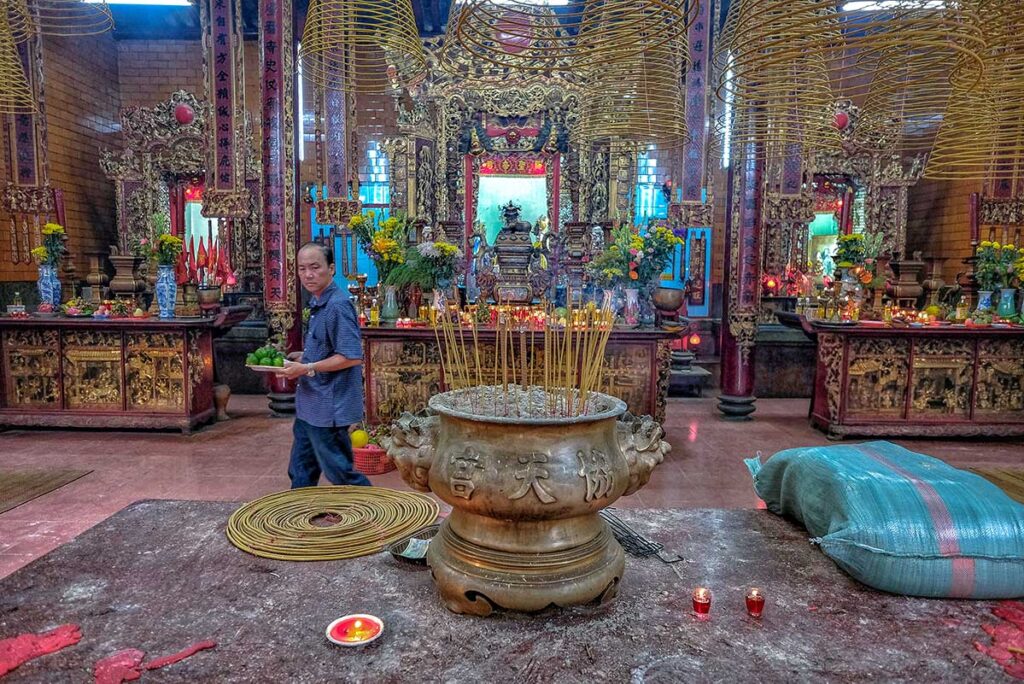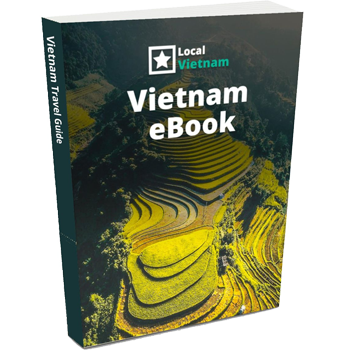What is Ong Pagoda?
Ong Pagoda, also known as the Quang Trieu Assembly Hall, is a small but lively Chinese temple in the heart of Can Tho. Built by the Cantonese community and dedicated mainly to Quan Cong, a military leader celebrated for loyalty and justice, it continues to serve as an active place of worship for the local Hoa people. While not a large or monumental site, it offers travelers a glimpse of Chinese-Vietnamese culture through its incense-filled halls, colorful details, and everyday spiritual practices.
History of Ong Pagoda
Ong Pagoda was built between 1894 and 1896 by Cantonese immigrants from Guangzhou and Zhaoqing who had settled in Can Tho. For the community, it was not only a temple dedicated to Quan Cong but also an assembly hall where people gathered, preserved traditions, and supported one another in a new land.
During the Vietnam War, the pagoda played a quiet role in sheltering revolutionary soldiers, a gesture that reinforced ties between the Hoa community and their Vietnamese neighbors. In 1993, it was officially recognized as a cultural historical relic, highlighting its architectural and cultural value. Today, Ong Pagoda remains a visible reminder of the long-standing presence and influence of the Hoa in the Mekong Delta, where their contributions can still be seen in local commerce, cuisine, and spiritual life.
Highlights when visiting Ong Pagoda
1. The architecture
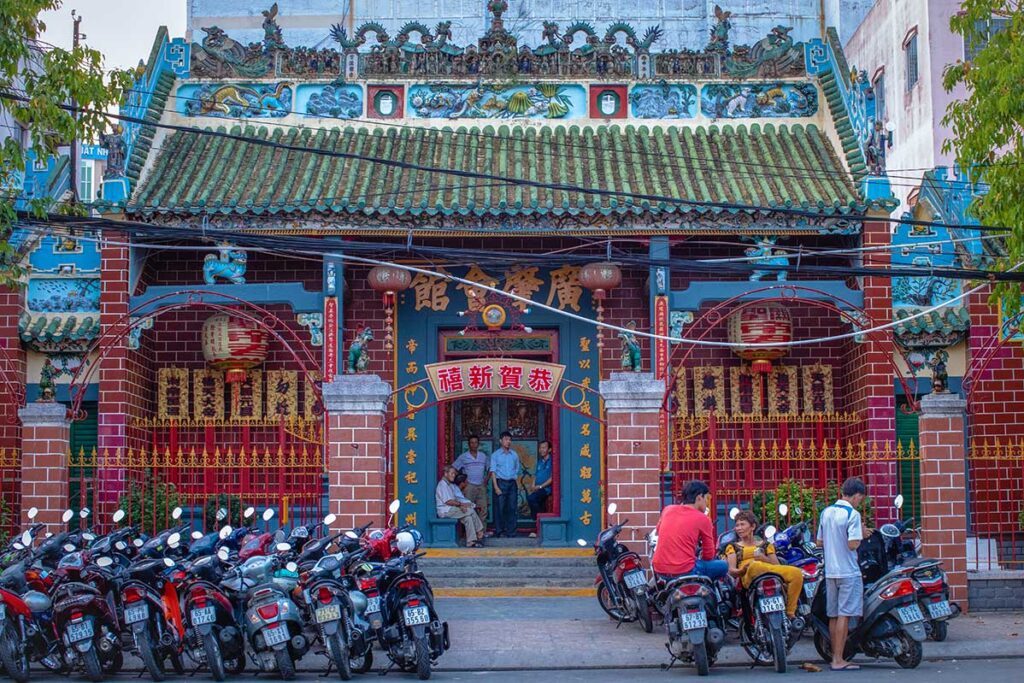
Ong Pagoda follows a traditional “Quoc” character layout, with four ranges of rooms surrounding a central courtyard called Thien Tinh. Many of the building materials—including stone pillars, tiles, and decorative carvings—were imported from Guangdong in the late 19th century, giving it a distinctly southern Chinese style.
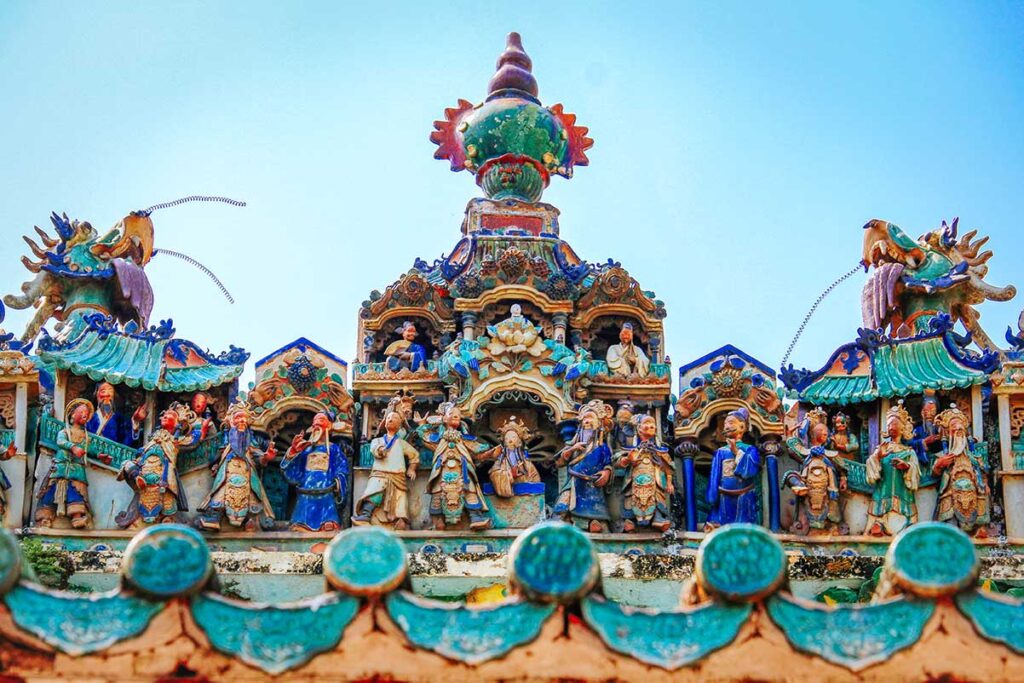
The façade is painted in bold colors, and the main wooden doors are guarded by large painted deities that set the tone before you even step inside.
2. Incense coils and atmosphere
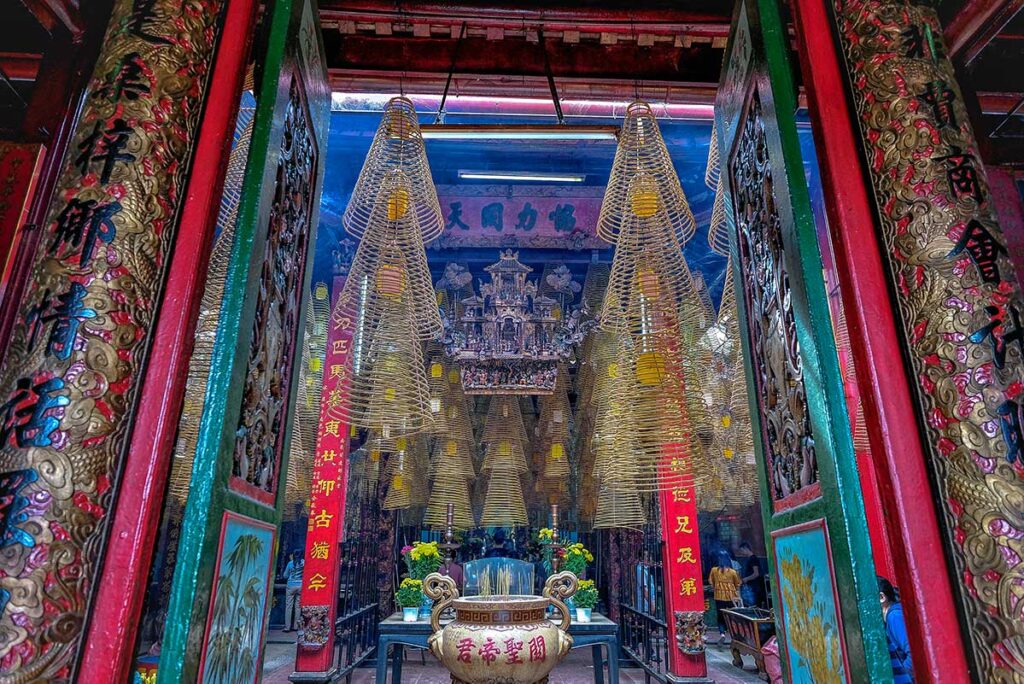
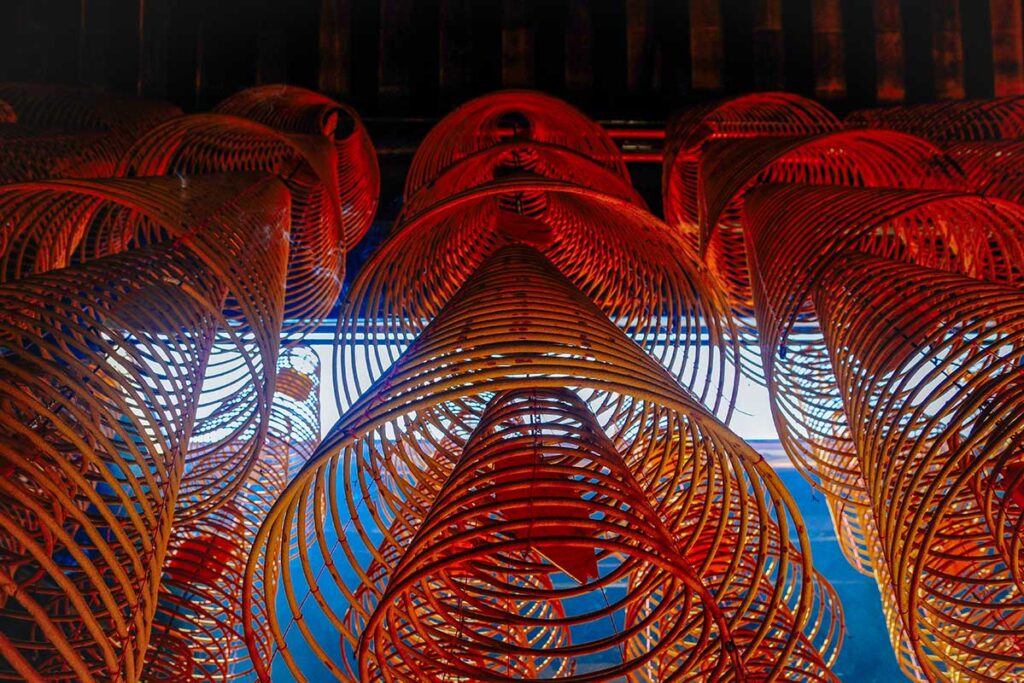
One of the first things you notice are the hundreds of giant incense coils suspended from the ceiling. Each coil can burn for a week or more, filling the air with a thick, smoky aroma that gives the temple a mystical feel but can also be overwhelming if you are sensitive to smoke. Visitors can attach small prayer cards with names or wishes to the coils, a custom that adds both meaning and atmosphere to the experience.
3. Main altar & deities
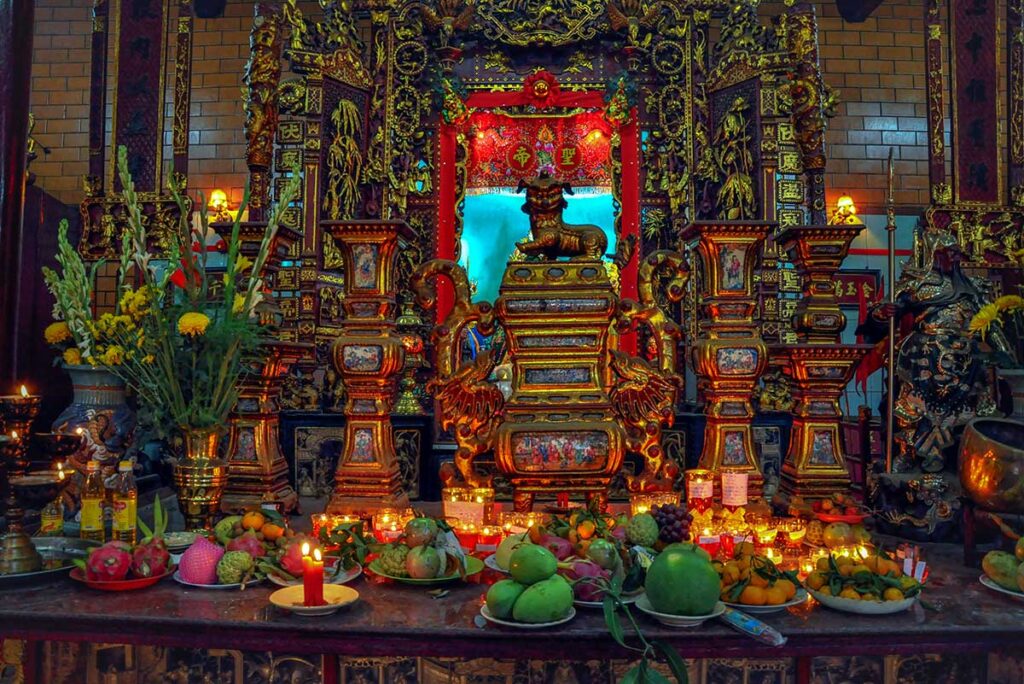
The central altar is dedicated to Quan Cong, the Chinese general known in Vietnam as Quan Thanh De, who symbolizes loyalty and justice. Surrounding him are a variety of other deities, including the Goddess of Mercy (Quan Am), the God of Fortune, Tho Dia (God of the Soil), and Thien Hau Thanh Mau (Goddess of the Sea). The mixture of Taoist, Buddhist, and folk figures shows how different strands of belief blend together in Hoa (Chinese-Vietnamese) religious practice.
4. Artwork and carvings
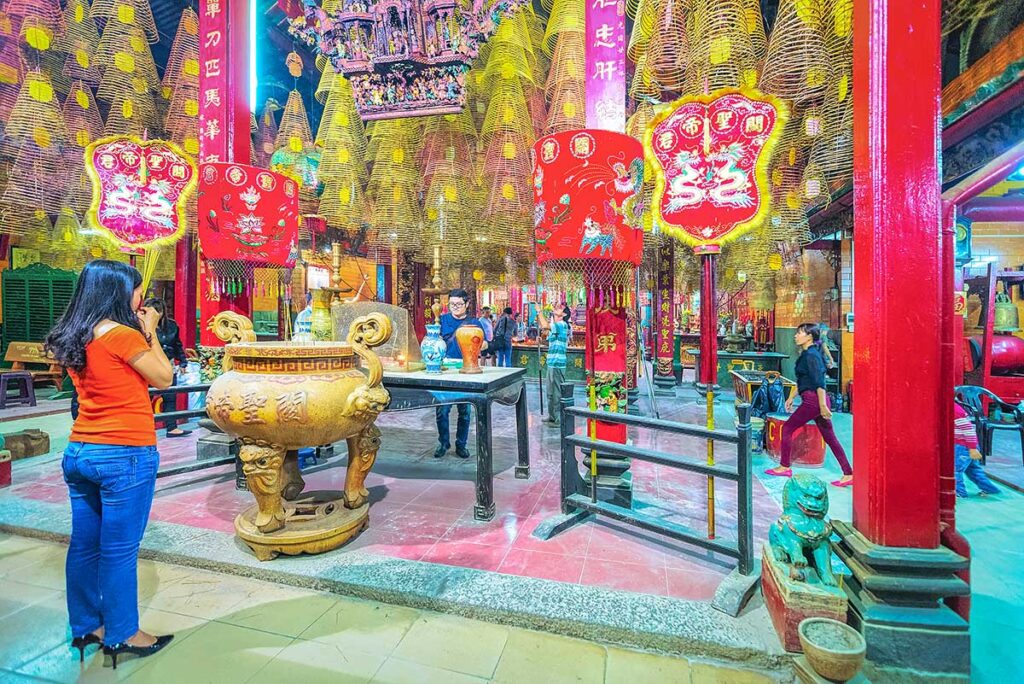
Every corner of the pagoda is decorated with traditional Chinese craftsmanship. Wooden reliefs and lacquered boards depict dragons, phoenixes, and seasonal flowers, while calligraphy in Trien and Thao styles adds a scholarly touch. Bronze bells, ceremonial urns, and even a dragon-shaped boat carving hanging from the ceiling show both artistry and cultural symbolism, making the small temple feel rich in detail.
5. Active worship and rituals
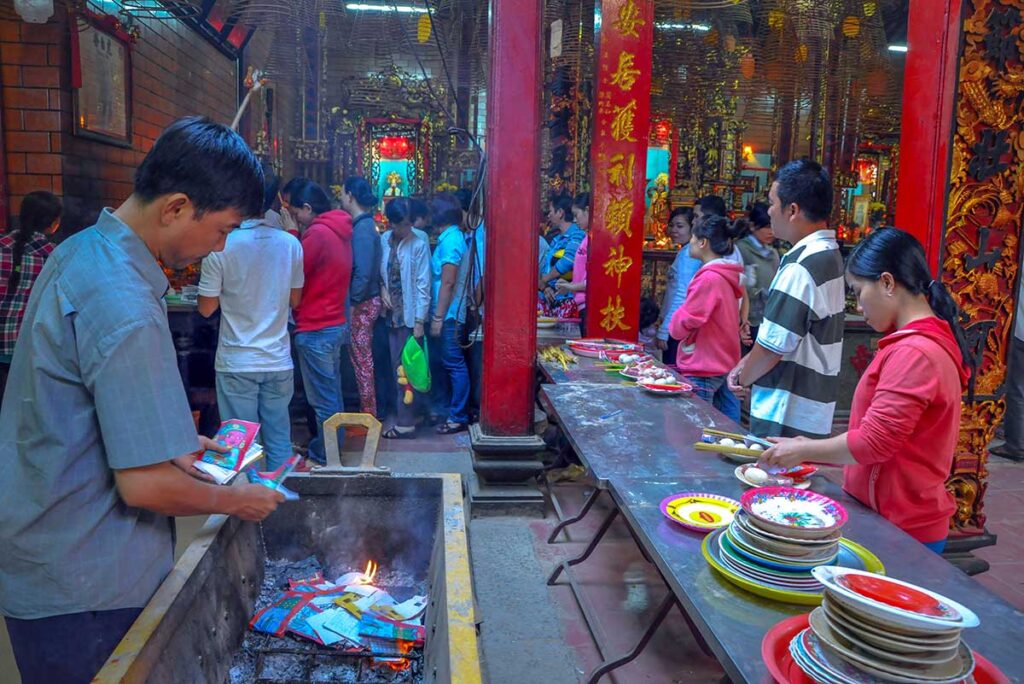
Ong Pagoda is not just a heritage site—it is still very much a living place of worship. Locals visit daily to light incense, pray, and make offerings that range from fruit to roast ducks or pigs, depending on the occasion. Visitors can often witness these rituals firsthand, from families burning incense for good fortune to large coils being lit to carry prayers upward for days on end. This everyday activity gives the temple an authenticity that can be more engaging than its architecture alone.
Festivals held at the Pagoda
Ong Pagoda is at its most lively during festivals, when worshippers and the wider community gather for ceremonies, performances, and offerings. The biggest celebration of the year is Tet Nguyen Dan (Lunar New Year), when the temple becomes a focal point for prayers of luck and prosperity.
Several other important dates are marked with deity birthdays, including:
- Phuc Duc (God of the Land) – celebrated on the 2nd day of the 2nd lunar month (usually March), with prayers for prosperity and protection.
- Thien Hau Thanh Mau (Goddess of the Sea) – honored on the 23rd day of the 3rd lunar month (around April/May), important for the Hoa community whose ancestors were traders.
- Quan Cong (the main deity of the temple) – his birthday on the 24th day of the 6th lunar month (often July/August) is the temple’s biggest annual event.
- Tai Bach Tinh Quan (God of Wealth) – celebrated on the 22nd day of the 7th lunar month (usually August/September), focused on good fortune in business.
Festivities often feature lion and dragon dances, lantern auctions, and the “eye-opening” ceremony, where the painted eyes of lion and dragon costumes are blessed before performances. These events draw crowds not only for worship but also for the cultural spectacle they create. Importantly, money raised through activities like lantern auctions is directed toward charitable causes such as school construction, supporting orphans and disabled children, and maintaining the temple itself.
Practical visiting information & Tips
Location & getting there
Ong Pagoda is located at 32 Hai Ba Trung Street, Ninh Kieu District, right by Ninh Kieu Wharf and directly opposite the Ho Chi Minh statue. The central location makes it easy to visit on foot if you are already exploring the riverfront area. It’s best included as part of a short walking circuit through Can Tho’s downtown sights.
Opening hours & entrance fees
The pagoda is generally open daily from around 7:00 to 20:00. Entry is free, though there may be a small fee for motorbike parking. Donations are welcome but not expected.
Dress code & etiquette
As with most temples in Vietnam, visitors should dress modestly, covering shoulders and knees. Shoes must be removed before entering the main areas. Photography is not allowed in the main hall, and elsewhere it should be done discreetly without flash. Keep your voice low, avoid touching sacred objects, and observe how locals make offerings before participating.
Visiting tips
The air inside can be thick with incense smoke, which adds atmosphere but may be uncomfortable if you are sensitive. The pagoda is busiest during festivals and on full moon days, so expect crowds if you visit at those times. For photos, late afternoon or evening works well, as the lanterns glow and the riverside nearby becomes more lively. Most travelers spend 15–30 minutes here, unless joining in a ceremony or festival.
Things nearby to combine your visit
Visiting Ong Pagoda is more worthwhile when combined with other sights, as it is located right in the middle of Can Tho’s riverside district. From the temple, you can easily walk to several attractions that make for a pleasant evening circuit around Ninh Kieu.
- Ninh Kieu Wharf – The city’s most popular riverside promenade, with a park, boat piers, and the pedestrian “Love Bridge.” It is especially lively in the evening when locals stroll and street vendors appear.
- Can Tho Central Market – Just a short walk away, this market buzzes during the day with fresh produce, snacks, and household goods. It’s a good place to catch a glimpse of everyday commerce.
- Ninh Kieu Night Market – In the evenings, the night market comes alive with food stalls, souvenirs, and a casual atmosphere that pairs well with a visit to the pagoda.
- Can Tho Museum – Around a 10-minute walk from the temple, this museum offers insights into the history, culture, and ethnic diversity of the Mekong Delta.
Altogether, Ong Pagoda works best as part of a walking circuit around Ninh Kieu. If you want to see more of the region—such as floating markets, fruit gardens, or cycling through the countryside—check our full Can Tho travel guide for broader options.
Is Ong Pagoda worth visiting?
Ong Pagoda is worth visiting if you are already in Can Tho city or exploring the Ninh Kieu Wharf area. It adds cultural depth to a riverside walk and offers a quick but memorable look at Chinese-Vietnamese heritage in the Mekong Delta.
That said, it is not a must-see if you are based in the countryside or rural parts of Can Tho. The pagoda is best experienced as part of an evening stroll or cultural sightseeing loop around the city center, combined with nearby markets and the riverside promenade.
